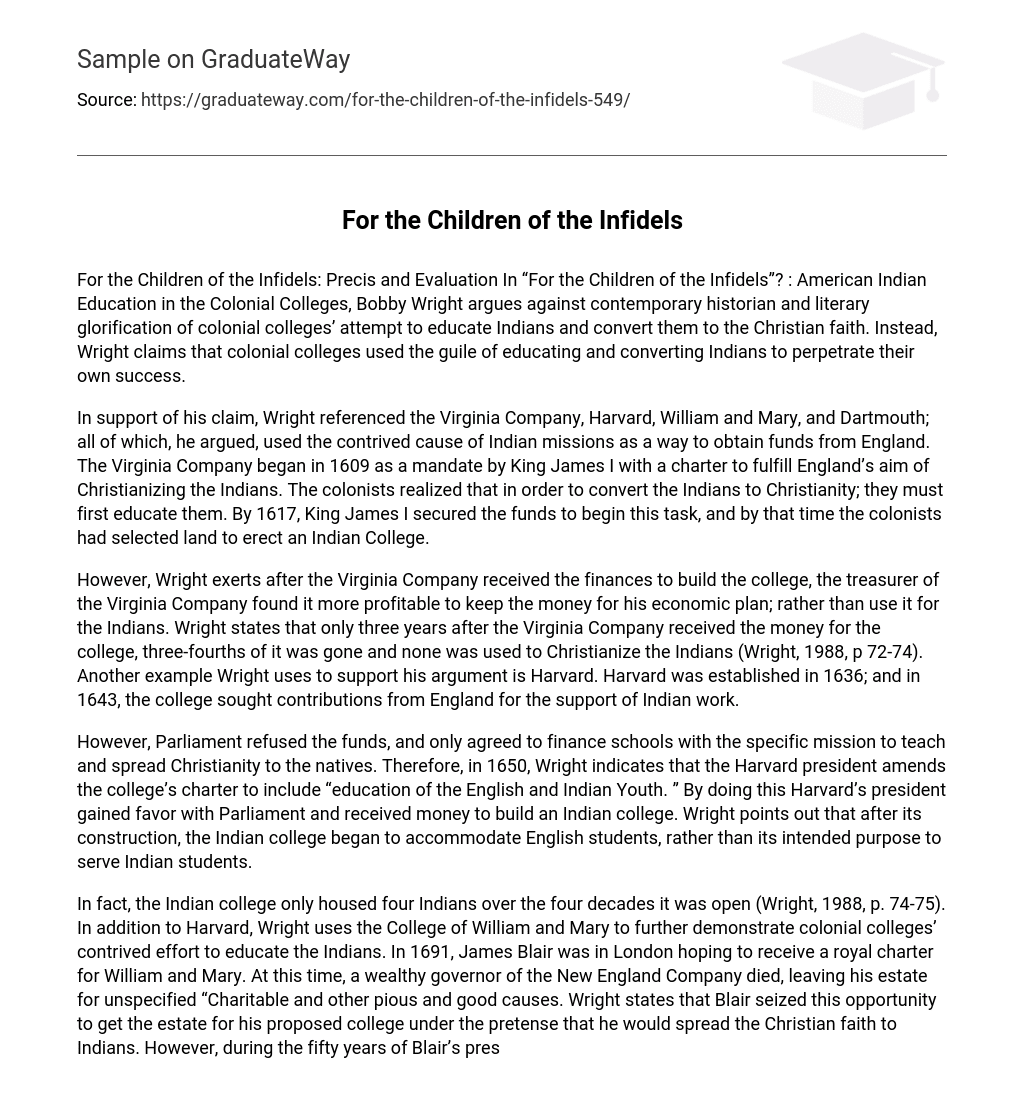According to Bobby Wright, American Indian Education in the Colonial Colleges disproves the modern depiction and praise of colonial colleges’ efforts to educate and convert Native Americans. Wright contends that the colleges deceitfully used education and conversion as a means to further their own achievements.
Wright supported his claim by mentioning several institutions such as the Virginia Company, Harvard, William and Mary, and Dartmouth. According to him, these institutions used the excuse of Indian missions to acquire financial support from England. The Virginia Company was established in 1609 by King James I with the purpose of converting Native Americans to Christianity. The colonists understood that education was necessary in order to achieve this goal. In 1617, King James I obtained the necessary funds for this mission, and by then the colonists had chosen a piece of land where they would build an Indian College.
However, Wright claims that after the Virginia Company received funding for the college, the treasurer decided to prioritize his economic plan over using the money for the benefit of the Indians (Wright, 1988, p 72-74). According to Wright, within just three years, three-fourths of the money allocated for the college had vanished without any being used for Christianizing the Indians. Wright also cites Harvard as another example to support his argument. He explains that in 1636, Harvard was established, and by 1643, the college was seeking contributions from England specifically for supporting work with the Indians.
However, Parliament denied funding, and only agreed to support schools that aimed to teach Christianity to the native population. In 1650, the president of Harvard amended the college’s charter to include educating both English and Indian youth. This move was made in order to please Parliament and secure funds for building an Indian college. Yet, contrary to its original intention to serve Indian students, the Indian college eventually started admitting English students.
The Indian college in fact only had four Indian students during the four decades it was open (Wright, 1988, p. 74-75). Additionally, Wright uses the College of William and Mary as another example of how colonial colleges made deliberate efforts to educate Native Americans. In 1691, James Blair was in London seeking a royal charter for William and Mary. Around the same time, a wealthy governor of the New England Company passed away, leaving his estate for unspecified charitable causes. Wright explains that Blair took advantage of this situation by acquiring the estate for his proposed college, claiming that he would use it to spread Christianity among Native Americans.
During Blair’s fifty-year presidency, William and Mary neglected to actively educate and spread Christianity to Indians, as evidenced by the college’s limited effort to educate only a few Indians during that time. Instead, the estate’s resources were dedicated to campus building and the education of English students (Wright, 1988, p. 75-76). Another example Wright provides to support his argument is Dartmouth College.
The founder of Dartmouth College, Eleazar Wheelock, sent an Indian to England and Scotland to raise funds for educating and converting Indians. The funds were then used to construct Dartmouth College. Yet, despite its initial purpose, Dartmouth soon became predominantly attended by English students. As the number of English students grew, the enrollment of Indian students declined. In the 1770s, only forty Indian students were educated at Dartmouth. (Wright, 1988, p. 76-78).
Overall, contemporary literature and historians commend colonial colleges for their endeavors in educating and Christianizing Indians. Nevertheless, Bobby Wright presents a contrasting viewpoint, suggesting that these efforts were actually self-serving for the colleges. Wright supports his argument by examining the actions of the Virginia Company and various colonial colleges such as Harvard, William and Mary, and Dartmouth. In conclusion, Wright’s article successfully challenges the prevailing notion that colonial colleges should be lauded for their attempts to educate Indians and propagate Christianity.
Wright initiated the argument by addressing the conflicting interests among the English, colonists, and Indians. The British aimed to “Europeanize” the Indians through the colonists, while the colonists lacked genuine motivation to educate and convert the Indians but relied on England’s financial support. Conversely, the Indians resisted giving up their culture. These conflicting interests serve as the foundation for Wright’s subsequent depiction of contrived attempts by colonial colleges to educate and propagate Christianity among the Indians. These examples enable readers to anticipate and comprehend the evidence Wright presents in support of his thesis.
Wright’s examples, constructed chronologically, include the Virginia Company (1609), Harvard (1636), College of William and Mary (1693), and Dartmouth College (1769). In each instance, Wright presents sufficient evidence to support his argument. The strongest support for the misuse of funds intended for Indian philanthropy is provided by Wright’s closing example of Dartmouth College. Overall, the article is well-written and provides detailed descriptions of each account from the Colonial period.
Wright’s impactful descriptions effectively persuade the reader. Bobby Wright’s article offers valuable insights into the relationship between England, colonial colleges, and the Indians. The information provided by Wright proves advantageous to present-day students, teachers, and historians.





